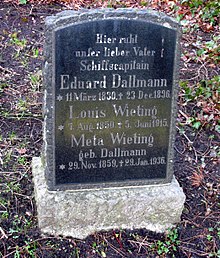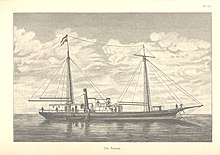Eduard Dallmann
Eduard Dallmann (born March 11, 1830 in Flethe , † December 23, 1896 in Blumenthal ) was a German whaler , explorer and polar explorer . With his travels he made a significant contribution to the knowledge of Antarctica .
Life
Eduard Dallmann's father Eduard Dallmann senior (1786–1877) was an officer in the Hanoverian Uhlans and after he left he had bought an estate in Schwanewede . He married Lucia Deetjen (1799-1837) from Vegesack , who came from a seafaring family. He soon sold the property again and moved to the boatman village of Flethe an der Unterweser, where he found employment as a credit counselor (appraiser) for the Blumenthal office.
When he was 15, Eduard Dallmann was hired as a cabin boy. On August 10, 1850, Dallmann began his service in Bremerhaven as the second helmsman on the full- rigged ship Otaheite for a whaling voyage lasting almost four years. At the age of 36, he was already a captain and was the first European to set foot on Wrangel Island in the Arctic .
When the whale populations in the northern seas declined, Dallmann was commissioned by the Deutsche Polar-Schifffahrtsgesellschaft to examine the Antarctic whale and seal populations with the auxiliary sailor Groenland, built in 1872 by the Wencke shipyard in Geestemünde . The Groenland was the first ship to be equipped with a mechanical auxiliary drive, which penetrated until shortly before the polar region (1873/74). The commercial success of the whaling expedition was small and just covered the costs incurred, but the discoveries were significant. In pursuit of some whales of outstanding discovered Navigator among others, the Bismarck Strait (Engl. Bismarck Strait ), the Neumayer Channel and the Kaiser Wilhelm island .
From 1877 to 1884 Eduard Dallmann participated in the extensive efforts to further develop Siberia economically , which were undertaken at that time. He tried several times to bring goods from Europe to the mouths of the Siberian rivers Ob and Yenisei in order to pick up grain loads and other Siberian products that had previously been transported to these places by barge. Due to the ice conditions in the Kara Sea , only four of Dallmann's seven attempts were successful, so that the financier of the ventures, the Bremen merchant Ludwig Knoop , decided to stop trading trips to Siberia.
In 1884 Dallmann was the nautical leader of the Finsch expedition to the north coast of New Guinea on the steamship Samoa . On November 27, 1884, in the presence of Otto Finsch and Captain Eduard Dallmann, the German flag was hoisted on the so-called “flag peninsula” in Finschhafen . Finsch made five trips with Eduard Dallmann in 1884 and 1885. They discovered the Friedrich-Wilhelmshafen , the Prinz-Heinrich-Hafen as well as the Adolf- and Finschhafen and the Kaiserin-Augusta- Rivers on the island of New Guinea .
From 1887 to 1893, Dallmann explored the northeast coast of New Guinea in the service of the New Guinea Company . Numerous groups of islands and straits were named by him.
family

Dallmann was married to Metta von Harten, who was also born in Flethe in 1832 and died in Hildesheim in 1882 . His sister Adelheid Juliane Dallmann was married to the captain Louis Wieting (1819-1883) since October 14, 1849 .
His daughter Meta (1859-1936) married Louis Wieting (1850-1915) from Rönnebeck , a nephew of Dallmann, who also became a well-known ship's captain. Dallmann died in his house in Langestrasse (now Captain Dallmann's house , Kapitän-Dallmann-Strasse 84) in 1896. He was buried in the Evangelical Reformed cemetery in Blumenthal. The grave no longer exists, but the tombstone was preserved. After standing by the old church tower for a few years and remembering the captain there, it was re-erected in 2015 as part of a project on the historical graves of the cemetery at the location where the grave was located. This location is indicated on an information board at the edge of the cemetery. Dallmann's son Eduard Dallmann, born in 1864, emigrated to the USA and is attested in New York in 1896.
Discoveries
Among other things, Dallmann discovered and named the following geographical objects:
- Booth Island
- Friedburg Island
- Gossler Island
- Krogmann Island
- Melchior Islands
- Neumayer Canal
- Petermann Island
- Rosenthal Islands
- Wilhelm Archipelago
Honors
- In the Antarctic, the Dallmann Mountains , the Dallmann Bay on the Brabant Island , the Dallmann Nunatak and the Dallmann Seamount all bear his name.
- The Dallmann Laboratory operated by the Alfred Wegener Institute for Polar and Marine Research on King George Island commemorates the pioneer and discoverer.
- In Bremen-Blumenthal the Kapitän-Dallmann-Straße and a fountain on the old market were named after him .
- The Dallman Harbor in New Guinea also reminds of him.
Web links
- Literature by and about Eduard Dallmann in the catalog of the German National Library
- Hans Roemer: Dallmann, Eduard. In: New German Biography (NDB). Volume 3, Duncker & Humblot, Berlin 1957, ISBN 3-428-00184-2 , p. 492 f. ( Digitized version ).
- Short biography on the website of the Alfred Wegener Institute (PDF)
- Short biography on private website
literature
- Peter-Michael Pawlik : From Siberia to New Guinea. Captain Dallmann, his ships and voyages 1830–1896. An image of life in self-testimonies and contemporary testimonies. Verlag Hauschild, Bremen 1996. ISBN 978-3931785253 .
Individual evidence
- ↑ Reinhard A. Krause, Ursula Rack (ed.): Journal, kept on board the steamship GROENLAND, Captain Ed. Dallmann, on the journey from Hamburg to d. Whale and seal fishing on the coasts of the South Shetland Islds. Coronation Isld. Trinity Land & Palmerland, run by Rud. Küper, Hamburg (PDF; 5.1 MB), Alfred Wegener Institute, Bremerhaven 2006, accessed on January 9, 2012
- ↑ Archive link ( Memento from August 21, 2007 in the Internet Archive ) Dittmar Dahlmann: Merchant shipping on the polar route
- ↑ Samoa trips. Travels in Kaiser-Wilhelms-Land and English New Guinea in 1884 and 1885 on board the German steamer Samoa. Hirt, Leipzig 1888, p. 6 .
- ↑ In the footsteps of Captain Dallmann. On: weser-kurier.de from July 8, 2011
- ^ John Stewart: Antarctica - An Encyclopedia . Vol. 1, McFarland & Co., Jefferson and London 2011, ISBN 978-0-7864-3590-6 , p. 386
| personal data | |
|---|---|
| SURNAME | Dallmann, Eduard |
| BRIEF DESCRIPTION | German whaler, explorer and polar explorer |
| BIRTH DATE | March 11, 1830 |
| PLACE OF BIRTH | Flethe |
| DATE OF DEATH | December 23, 1896 |
| PLACE OF DEATH | Blumenthal |

